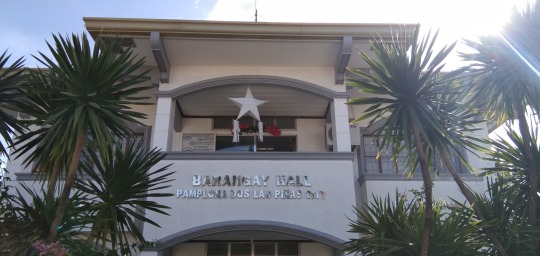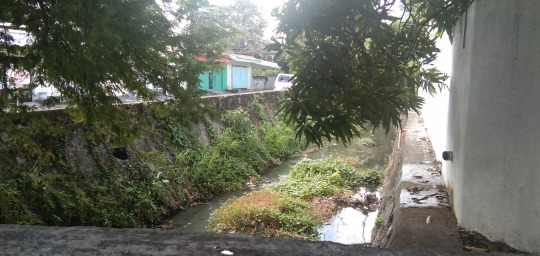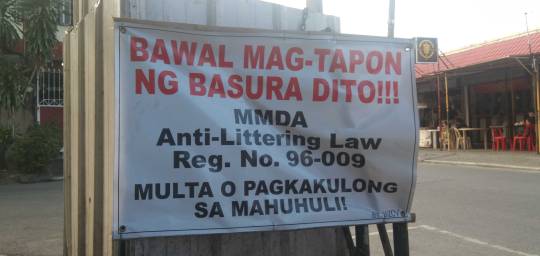Don't wanna be here? Send us removal request.
Text
Survival 101: A Disaster Risk Reduction and Management Plan
Barangay Pamplona Dos, Las Piñas City
The Philippines has a high vulnerability to natural hazards which attributes the country’s geographic position in Southeast Asia. Disasters like typhoons, earthquakes, and volcanic eruptions ravage the country every year, leading to the loss of lives and millions of damages to infrastructure and livelihood. Therefore, all cities and barangays must prepare their Disaster Risk Reduction & Management Plan in order to be ready for disasters and lessen its negative impacts on their community.
14 December – I visited the Barangay Hall of Pamplona Dos in Las Piñas City. The visit made me learn about the different ways of how the community prepares for disasters and the rules and plans that they make to spread awareness to each member of the community.

Barangay Pamplona Dos covers 8 zones, and all of these have common experiences when disasters happen. Typhoon/Flood is the most prevalent disaster that the community experiences. On usual typhoons, they don’t experience too much damage since it is still tolerable.

One of the worst disasters that they’ve experienced was the Typhoon Ondoy last September 2009. It caused destruction of properties, loss of lives and experienced a lack of coordination in the medical assistance and lack of support from evacuation operations. Another one is a typhoon last 2006 which caused flooding to many areas due to lack of preparedness in case of disaster and unclogged drainage systems. Those who live in low-lying areas are the most vulnerable to disasters like this, most especially, they are the ones close to the community’s creek. In disasters like floods and earthquakes, they are vulnerable because of the unsafe design of some houses built in the community and the lack of knowledge and skills on preparedness and protective measures. In cases of fire, they are likely vulnerable due to poverty and lack of education.


Ondoy-unscathed Las Pinas Has Different Story TodayABS-CBN News - https://news.abs-cbn.com/nation/metro-manila/08/19/13/ondoy-unscathed-las-pinas-has-different-story-today
The heads of the barangay were alarmed by the different difficulties that they experience in their community during disasters therefore, they implemented ways on how they can prevent these negative effects to their community. One of which is they conduct seminars to educate the members of the community about the different practices to be done during times of disasters. They also have a mandatory drill for them to be familiar with the evacuation areas and practices to take note in times of the disaster. They also implement the proper segregation of waste to prevent clogged drainage.


Alternative Learning System 2015 Las Piñas East National High Schoolhttps://www.facebook.com/740189109411796/posts/late-uploadearthquake-drilllpenhsals2018alsisreal/1704648796299151/
The barangay also has its Disaster Risk Reduction and Management Plan which shows all the important things to consider to be ready in times of disaster. This includes their community’s profile and population so that they will be familiar with its capacities and vulnerabilities, experiences, and risks, the practices to be done, the evacuation procedures, and other preventive measures.

The leaders of the barangay aim for the safety and protection of all the residents of the Barangay in times of disasters that is why they provide a layout of the plans for their evacuation. They want to make sure that all will be fully equipped with the right amount of knowledge and skills to prevent such risks to happen.
Currently, the leaders of the barangay coordinates with LGU’s and Barangay Officials, conduct Rescue and Evacuation Operations and have a regular inspection of the physical state of their community to ensure its safety and to fix broken portions immediately. They also have a list of the breakdown of the equipment that they need for rescue operations. For each disaster, they have assigned different officials to lead the evacuation and safety practices and for the proper dissemination of tasks and responsibilities.




One of the issues that are on the heat in the community now is the unsafe construction and design of the houses. This makes the residents vulnerable to all the prevalent disasters that may affect the community. Also, some of those who belong in the informal settlers’ sector experience hardships in dealing with disasters due to their location. These issues are hot due to the complaints of the residents themselves.
When the local government hears about this, they can help by giving financial support to the community and by providing programs to help improve the infrastructures in the area to avoid the possibility of worse effects of disasters.

As we all know, our country is at the Pacific Ring of Fire and in between the Pacific and Eurasian Fault which makes it vulnerable and prone to disasters like earthquakes and volcanic eruptions. The climate change also affected the weather in our country that is why we experience sudden changes in the weather in most areas.
Because of the widespread of the news of different disasters occurring around the country, the Philippine Government thought of improving and has successfully made significant strides in the implementation of Disaster Risk Reduction (DRR) Planning and activities through the development of the National Disaster Risk Reduction and Management Council (NDRRMC) which acts as the lead agency for DRR in the Philippines. The disaster focal points are the NDRRMC and the Office of Civil Defense (OCD). The Department of Social Welfare and Development (DSWD) is responsible for leading immediate disaster relief efforts. The Armed Forces of the Philippines (AFP) is a primary responder in disasters and have been deployed often to several disaster relief operations in the country in recent years. The Philippines has endured disasters that involve national and international assistance.


Philippines: Disaster Management Reference Handbook (march 2018) - Philippineshttps://reliefweb.int/report/philippines/philippines-disaster-management-reference-handbook-march-2018
Likewise, in a community, the leaders also study the area and analyze which among are the problems and how can they be able to help them in times of disasters. They also give assignments of tasks to each head for them to make sure that they can monitor the population. They also provide alarm systems to make sure that the residents are well-informed if there is a disaster happening. They also make sure that they have coordination with those who can help them provide the equipment, food and medical assistance that they need.
Disaster Preparedness and Awareness is highly prominent, for we all know that some happen unexpectedly. I was able to see the significance of each step in the plan to survive in disasters. Besides the importance of having a DRRM plan, it is also a must to ensure that everyone is being able to practice it because if they only know it through words, they may find it hard to practice and apply it if ever it happens in real life.
Our country is vulnerable to disasters so this should be a wake-up call for us to think of ways to protect ourselves from the negative effects of these disasters on our country. The lives of many people are at stake if we don’t get to be educated and equipped with the right amount of knowledge about safety during disasters. So, as a member of this community and this nation, I can help prevent by creating programs or participating in activities that will help ensure that each one has a share of knowledge to the capacities and vulnerabilities of the community.
It is highly necessary to carry out, conduct and take part in seminars, programs, and drills that will help us learn and enhance our skills in survival. We must take into consideration the lives of the whole population because one wrong move or lack of preparedness may affect the lives of many.
Disaster Ready, Live Life Safely.
3 notes
·
View notes